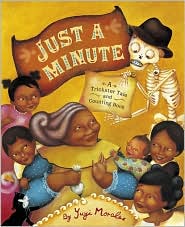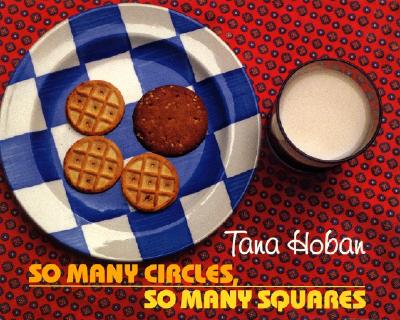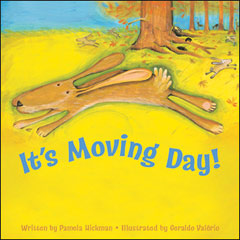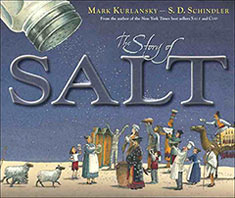Yesterday I posted the results of the BCCB Blue Ribbon Awards in Nonfiction on my other blog. While I found the selected books to be excellent choices, I was more than a little disappointed that not one science book made the list. I was also disturbed to read this statement regarding the selection of this year’s choices.
Then we turned our gaze to our sparse field of nonfiction and decided that we’d rather sacrifice list length than standards.
Sparse? They’re kidding, right?
I’ve decided to correct this HUGE oversight by naming my own award winners for science. Using the categories and criteria the NSTA uses each year in selecting the books that appear on its list of outstanding trade books for science, I have reviewed the books in my teaching collection and come up with a list of my own. The criteria are:
- The book has substantial science content.
- Information is clear, accurate, and up-to-date.
- Theories and facts are clearly distinguished.
- Generalizations are supported by facts, and significant facts are not omitted.
- Books are free of gender, ethnic, and socioeconomic bias.
So, without further ado, here are my choices for the best science books for children and young adults (K-12) published in 2007.



Archaeology, Anthropology, and Paleontology
Dinosaur Eggs Discovered!: Unscrambling the Clues by Lowell Dingus, Rodolfo A. Coria, and Luis M. Chiappe – This amazing book recounts the discovery and subsequent work of a group of scientists who stumbled upon the remains of a dinosaur nesting ground in Patagonia in Argentina. In addition to dinosaur eggs and embryos, they also discovered the fossilized bones of an adult dinosaur.
The Discovery and Mystery of a Dinosaur Named Jane by Judith Williams – Follow along with an expedition to the Badlands of Montana, where the greatest treasure, a new dinosaur, is discovered on the last day of the dig. Photos of the expedition make this one come alive.
Biography
George Washington Carver: An Innovative Life by Elizabeth MacLeod – This engaging text introduces readers to a George Washington Carver that just isn’t described in most biographies for children. Using photographs, newspaper excerpts, journal pages, timelines and more, this book celebrates and illuminates the life of this important African American scientist. Read my review.
The Planet Hunter: The Story Behind What Happened to Pluto by Elizabeth Rusch – This biography of Mike Brown details his youth and work as an astronomer. You’ll learn how his discoveries led astronomers to reconsider the definition of a planet, and how this led to Pluto being demoted.
Earth and Space Science
Tracking Trash: Flotsam, Jetsam and the Science of Ocean Motion by Loree Griffin Burns – In this entry in the Scientists in the Field series, readers follow the research of several ocean scientists and learn how floating garbage has helped them conduct their research. The scientists in this book track “The Garbage Patch,” a mass of floating plastic trash that extends close to 1,000 nautical miles in the waters between California and Hawaii. Read Mindy’s review at propernoun.net.
Will It Blow? Become a Volcano Detective at Mount St. Helens by Elizabeth Rusch – “Your mission, if you choose to accept it, is to predict a Mount St. Helens eruption.” With cartoon drawings, hands-on experiments, lots of clues (science explanations and diagrams), this is one entertaining and informative book on volcanoes. Also included are a vocabulary list and list of related books and web sites.
Environment and Ecology
One Well: The Story of Water on Earth by Rochelle Strauss – In a series of double page spreads containing both informational paragraphs and short, factual boxed insets, readers learn about the distribution of water on earth, the water cycle, water’s essential role in life on Earth and watery habitats. From here, the author looks at how people use, need and access water. The book concludes by looking at demands on the well, pollution, and saving our water. Read my review.
Health and Science
Sneeze! by Alexandra Siy – What makes your nose so itchy and twitchy that you sneeze? Readers get to examine black and white photos of irritated noses and color enlargements of the microscopic things causing the problem. Then they can find out about the 9 reasons for sneezes while learning all about this reflex. This one is highly informative and fun!
Life Science
Being Caribou: Five Months on Foot with a Caribou Herd by Karsten Heuer – This is an adaptation of Heuer’s adult title that describes the five months he and his wife spent following the migration of more than 100,000 Grant’s caribou to their breeding ground in the Arctic National Wildlife Refuge (ANWR). This is an amazing story that helps readers to understand the delicate Arctic ecosystem.
Bugs Up Close by Diane Swanson – This book provides a highly magnified, up-close and personal view of some creatures belonging to the largest and most widespread group of animals on earth. This book is jam-packed with interesting facts about insects.
Frog Heaven: Ecology of a Vernal Pool by Doug Wechsler – Vernal pools are temporary wetlands that dry each summer, then refill during the fall, winter and spring. This book examines the changes in a vernal pool in the woods of Delaware and describes the creatures that live there. Read Susan’s review at Chicken Spaghetti.
Lions, Tigers and Bears: Why Are Big Predators So Rare? by Ron Hirschi – With incredible photographs by Thomas D. Mangelsen, this book looks at cougars, polar bears, lions, cheetahs, tigers, grizzly bears and killer whales and examines why their numbers are not only small, but dwindling. Read Liz’s review at A Chair, A Fireplace & A Tea Cozy.
Living Color by Steve Jenkins – Using his distinctive cut paper collage, Jenkins explores the meaning of color in the animal world. Arranged by color, each animal is accompanied by a short paragraph of information. Did you know some animals color is a result of their diet? Or that some animals change color when they reach adulthood? There is much to learn and enjoy in this bright and colorful book.
Turtle Summer: A Journal for My Daughter by Mary Alice Monroe – This journal written by a mother for her daughter recounts their summer tending turtles together during the loggerhead nesting season. The journal begins in May, when female loggerhead turtles return to the beach they were born on to lay their eggs, and ends in July when the hatchlings return to the sea. At the end of the book is a section entitled For Creative Minds, which contains turtle facts, reproducible forms, and directions for making your own nature scrapbook. Read my review.
Vulture View by April Pulley Sayre – This informative text introduces readers to the world of the turkey vulture in rhythmic, precise text, accompanied by gorgeous cut paper collages. Read my review.
What’s Eating You?: Parasites–The Inside Story by Nicola Davies – Every living thing has a habitat where it finds food and shelter and reproduces, but some organisms make their homes on other living things. This creepily entertaining and fact-filled book let’s us in on the secret lives of parasites.
Where in the Wild? Camouflaged Creatures Concealed … and Revealed by David Schwartz and Yael Schy – Amazing photographs of animals hidden in plain sight, clues to their location in the form of poetry, and background info galore hidden in the gatefold all come together in this handsome and highly effective book about camouflage. Listen to the podcast review at Just One More Book!!.
Physical Science
The Periodic Table: Elements With Style! by Adrian Dingle – Undeniably entertaining, Basher’s illustrations for each element are creatively telling (with a decidedly Japanese anime kind of flair), and nicely supported by the descriptions, which read like personal ads. Read my review.
Wired by Anastasia Suen – This book about how electricity makes it from the power station to your home fills a much needed gap in the literature. The book works on two levels, with short poetic text that moves the story (and electricity) along, and informational text that explains each step along the way.
Science-Related Careers
Whale Scientists: Solving the Mystery of Whale Strandings by Fran Hodgkins – This entry in the Scientists in the Field series looks at how scientists are working to discover the reasons why whales beach themselves. While they have no definitive answer, this book explores the theories, including illness or injury, hearing damage, magnetic attractions, confusing geography and more.



Have you seen a science book published in 2007 that you believe should make this list? Leave me a note and let me know about it. I’ll take a look and let you know what I think.











